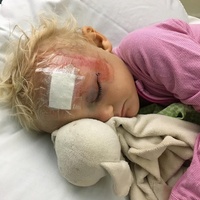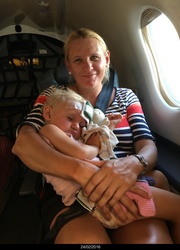Thomas’ Journey
At seven weeks old little Thomas got very ill and began struggling to breathe. What happened to him can happen to any baby in the world.
 There’s no more beautiful a sound than the gasp of a newborn drawing its very first breath. And no worse than the shallow rasp of a very ill child who’s fast approaching his last.
There’s no more beautiful a sound than the gasp of a newborn drawing its very first breath. And no worse than the shallow rasp of a very ill child who’s fast approaching his last.
For Brooke and Lachlan, hearing their seven-week old baby trying and failing to suck enough air into his badly infected lungs was almost unbearable.
In just four days, little Thomas had gone from having what seemed like a mild cold, to a hacking cough, to a raging fever, to violent projectile vomiting, to struggling to breath.
To make matters even worse, they were in the small town of Roma, 500km away from the intensive care that Thomas needed urgently.
Brooke and Lachlan feared their baby’s little body might not have the strength to survive the eight-hour drive. And so they were overwhelmed when doctors at their small local hospital called Retrieval Services Queensland to their aid. Retrieval Services worked quickly with the RFDS to make sure help was on its way.
Mum Brooke will never forget the moment our aeromedical team arrived on the scene:
“It was the first time I felt safe in four days. Watching them hook Thomas up to their monitors and high-tech ventilators- I knew that my baby was in the best possible hands.”
Brooke was right to feel comforted. Because not only are the Flying Doctors and the Queensland Health aeromedical team they work with some of the most well trained and highly experienced emergency personnel in the world. They are also among the best equipped.
Shortly after receiving the emergency call for help, two paediatric emergency specialists from the Lady Cilento Children’s Hospital and a highly experienced RFDS Flight Nurse were in the air and speeding their way to Roma.
Once there, they placed Thomas in a Humidicrib to help ventilate him and regulate his temperature on the journey. They also attached him to a Propaq monitor so that they could keep an eye on his vital signs.
They then loaded Thomas and mum Brooke on board their aircraft and, just over an hour later, they touched down in Brisbane where an ambulance waited to rush him to the paediatric intensive care unit.
It turned out that Thomas had a severe, life-threatening viral lung infection. He was extremely ill, but thanks in no small part to the speed and experience of the Flying Doctor, and the exceptional medical equipment we carry on every flight, he pulled through. And just five days later he was ready to go home with mum and dad.
Millions of people living in remote communities around the world would dream of having an exceptional, airborne emergency service to keep their children safe. But here in Queensland, we don’t have to. And that’s in no small part down to the generosity of people like you.

 One afternoon in February, Ric jumped on a quad-bike with daughter Clare for a short ride back to the house. The family had been working on their 54,000 acre property in south-west Queensland and had just finished in the yards, after a day of mustering.
One afternoon in February, Ric jumped on a quad-bike with daughter Clare for a short ride back to the house. The family had been working on their 54,000 acre property in south-west Queensland and had just finished in the yards, after a day of mustering.
 As he rested in his cabin, he began to feel unwell.
As he rested in his cabin, he began to feel unwell. Back to RFDS QLD site
Back to RFDS QLD site